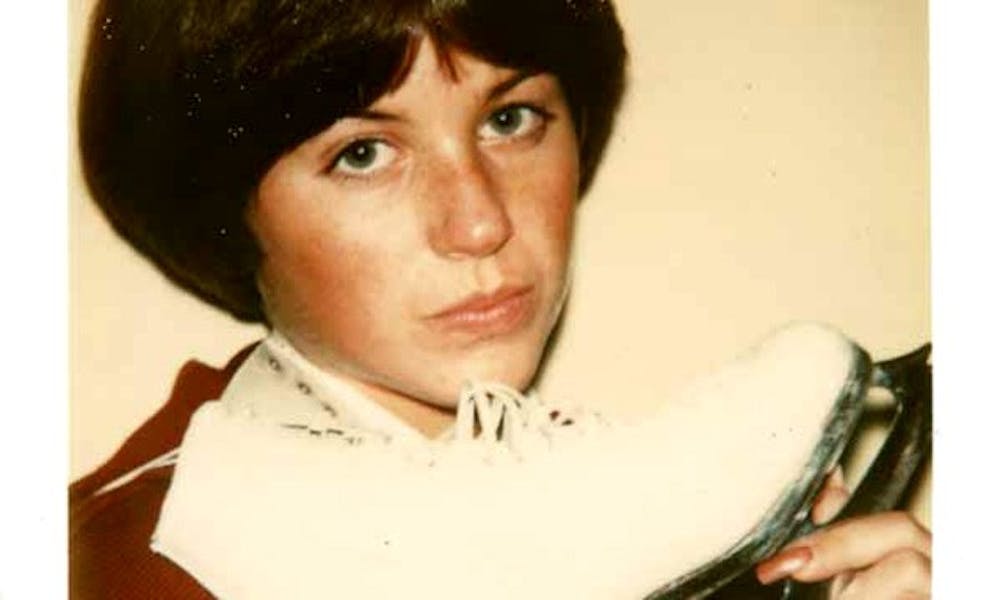Olympic ice skating champion Dorothy Hamill, doe-eyed and with her characteristic chestnut bob, holding up an ice skate. Iconic fashion designer and Durham native Andre Leon Talley—now editor-at-large for Vogue—almost unrecognizable in black and white, circa 1980, wearing a Christmas sweater. A youthful Bianca Jagger, bare-shouldered and sporting bright red lipstick, pouting for Andy Warhol’s Big Shot Polaroid camera.
The images on display in the Nasher Museum of Art as part of Big Shots: Andy Warhol Polaroids are a titillating glimpse into the social life of pop art titan Andy Warhol, and the mystique of fame, glamor and celebrity excess of his heyday.
Thirty-seven thousand visitors have passed through the Nasher to see the exhibit between its Nov. 12 opening and Feb. 14, said Wendy Livingston, manager of marketing and communications. It will be on display until Sunday.
At first glance, Big Shots seems to have little to do with thriftiness. But strangely enough, the show—a collaboration between the Nasher, the Ackland Art Museum at the University of North Carolina at Chapel Hill and the Weatherspoon Art Museum at the University of North Carolina at Greensboro—was born at least in part out of the need to do more with less in lean times. Even the high-brow world of art has been touched by financial concerns.
In 2007, the Andy Warhol Foundation for the Visual Arts, in celebration of its 20th anniversary, launched its Andy Warhol Photographic Legacy project, presenting each of 180 colleges and universities around the country with approximately 150 Polaroid photographs and black and white gelatin prints taken by Warhol between 1970 and 1987—including the Nasher, the Ackland and the Weatherspoon.
After receiving the gifts, the curators at all three institutions decided to pool their resources to create the Big Shots exhibit—a move that would allow all three museums to put on a high star-power show from a big-name artist while minimizing costs to each. After its run at the Nasher, Big Shots will travel to Greensboro this summer and be on display from June 6 to Sept. 19, and will finish off the year in Chapel Hill, from Oct. 2 to Jan. 2.
“We decided the exhibit would be richer and bigger than if we each exhibited our own individually,” said Kimerly Rorschach, director of the Nasher. “The exhibition doesn’t include everything we received, but we picked the most interesting ones that told the most complete story of Warhol’s work.”
Organizers from all three museums agreed that the collaboration adds a depth and breadth to the exhibit that may have been missing if each had only drawn from its own collection.
“It seemed like a natural thing. We had been talking for some time about ways to collaborate,” said Elaine Gustafson, curator of collections at the Weatherspoon. “We’d all received these gifts of Warhol and we were all required to exhibit them as part of the gift agreement.”
The partnership between three academic art institutions, all within an hour of each other, may not have happened had cost-effectiveness not come to the forefront of the curator’s minds.
“We’ve never done that before. Usually we think in terms of marketing. We don’t really feel that we necessarily compete with these other institutions,” Livingston said. “We feel like they are great art museums and they help to create a good arts scene around the Triangle, but usually we think of collaborating with institutions in completely different markets. But because of the economy, we knew that it would be less expensive to collaborate with these institutions and we’d thought we’d give it a try.”
Indeed, the crunch of economic concerns can be seen in other places in the exhibit—multiple Polaroids are framed together in an effort to save on expenses.
“The economic issues caused us to be more creative in different ways,” said Emily Kass, director of the Ackland. “If the money was flowing and the endowments were booming, we’d be looking farther, to more lavish institutions but all of us have really decided—being so uncertain—to really be cautious and prudent about what we do.”
But the curators involved in organizing the exhibit said financial constraints were a blessing in disguise, allowing the three institutions to do something they had never done before, and allowing a North Carolina audience to see the exhibit in three different ways.
“[Our recent shows] are superstars of the art world, but this is all original research and original presentation,” said Trevor Schoonmaker, curator for contemporary art at the Nasher and one of the chief organizers of Big Shots. “Instead of just having a huge Picasso painting show that people can see at the MoMA or a show that is Warhol’s greatest hits—which is also very expensive and difficult to get the loans for—this enables us to do this in a way that’s new but that’s also now part of our collection. It allows us to collaborate with two other regional museums that we never get to collaborate with because they’re so close. So it’s a great opportunity.”
In addition, the three institutions are working to put their own individual spin on the exhibits. The entrance to the exhibit of the Nasher iteration, for example, uniquely features Warhol’s paintings of the wife and three daughters of Raymond Nasher—the museum’s namesake—next to their accompanying Polaroids.
Curators emphasized the value of Big Shots lies in its ability to offer insight into the creative process of a superstar artist. Indeed, Warhol’s Polaroids served as his preliminary sketches before he turned to the final product. Most of the Polaroids have never been seen before.
“We’re all teaching institutions, and it really shows Warhol’s work in progress and how he flows an idea into a final product,” Gustafson said. “It’s an excellent teaching tool.”
Get The Chronicle straight to your inbox
Sign up for our weekly newsletter. Cancel at any time.

